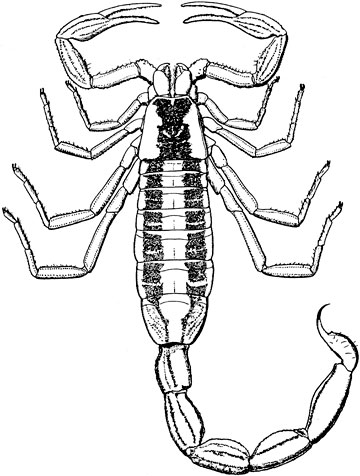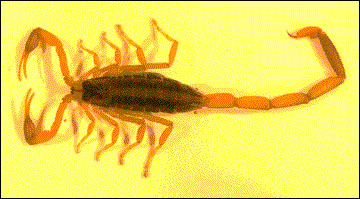Scorpions make up a small order of arthropods (Scorpiones) closely related to spiders (Araneae). They have eight legs, a combined head and thorax called a cephalothorax, and a segmented abdomen. At the front of their bodies is a pair of large pincer-like appendages, which they use for catching prey. Their abdomens are segmented with an elongated tail ending in a stinger, usually carried curved up and over the body.
Several species of scorpions are found in the United States, with most inhabiting drier habitats in the South and Southwest. The only naturally occurring species in Missouri is the striped scorpion, Centruroides vittatus (Figure 1). This species resides in the southern half of Missouri and the Ozark region. Adult striped scorpions are 2.5 inches long, yellowish tan with two broad, darkened longitudinal bands on the top of the abdomen. The female produces living young, which she carries on her back for five to 15 days until they leave and become independent. After three to four years, the young reach maturity and may live two to five years as adults.


Scorpions hide during the day and are active at night. Although usually found in drier habitats, they require moisture and may be attracted to moist areas. They tend to live under boards, stones or other objects; or beneath loose bark on trees and logs. They generally do not like extremely high temperatures and, during the summer, may enter the living areas of a home seeking relief from heat and dryness. When they come indoors, they are most often found in crawl spaces and attics.
Scorpions can survive well in terrariums and make interesting pets. They feed on spiders and soft-bodied insects. Small prey may be eaten immediately; larger prey are stung and then eaten after they stop moving.
Scorpion stings
All scorpions have venom glands located in the bulbous last segment of the abdomen, which also bears a stinger. Scorpions rarely sting humans except when pinned against the skin. The sting of the striped scorpion usually results in pain, swelling and redness at the sting site, which lasts for a few hours and has been described as similar to a bee or wasp sting. A sting does not usually require medical attention. Some species of scorpions, found only in southern Arizona and Mexico, have been responsible for human deaths.
Control measures
To make the area around the house less hospitable to scorpions and block their entrance into the house, take the following control measures:
- Remove boards, stones, wood piles and similar hiding places from around the house.
- Store firewood and lumber off the ground. Doing this also helps to eliminate insect populations that serve as a food source for scorpions.
- Caulk cracks and crevices under and around doors and windows.
- During dry weather, spread wet burlap bags on the ground around the house to trap scorpions. The moist bags attract scorpions, which can then be killed by crushing with a heavy object.
- Create an outdoor pesticide barrier to temporarily deter scorpions from coming indoors. Use an over-the-counter pesticide labeled for use on crawling pests outdoors. Make sure scorpions are listed on the label and follow all label instructions. Before making the barrier, treat weep holes in brick veneer and around basement window wells. To create the barrier, spray an area 3 to 4 feet wide out from the foundation on the ground and 2 feet up the outside wall. Apply the pesticide to the point of runoff on the foundation and outside wall.
To kill scorpions that have already invaded the home, treat attics, wall voids and crawl spaces with over-the-counter indoor pesticides. Placing dust formulations inside void spaces and spraying liquids into cracks and crevices where scorpions hide are more effective control measures than general surface spraying.
Use pesticides wisely and safely
- Apply only where needed or justified.
- Use care when handling, mixing or applying.
- Keep in original containers complete with labels.
- Keep out of reach of children.
- Read, understand and follow directions on the label and heed all precautions.
- Carefully and properly dispose of unused portions of diluted sprays and empty containers.
- Do not contaminate food or dishes.
